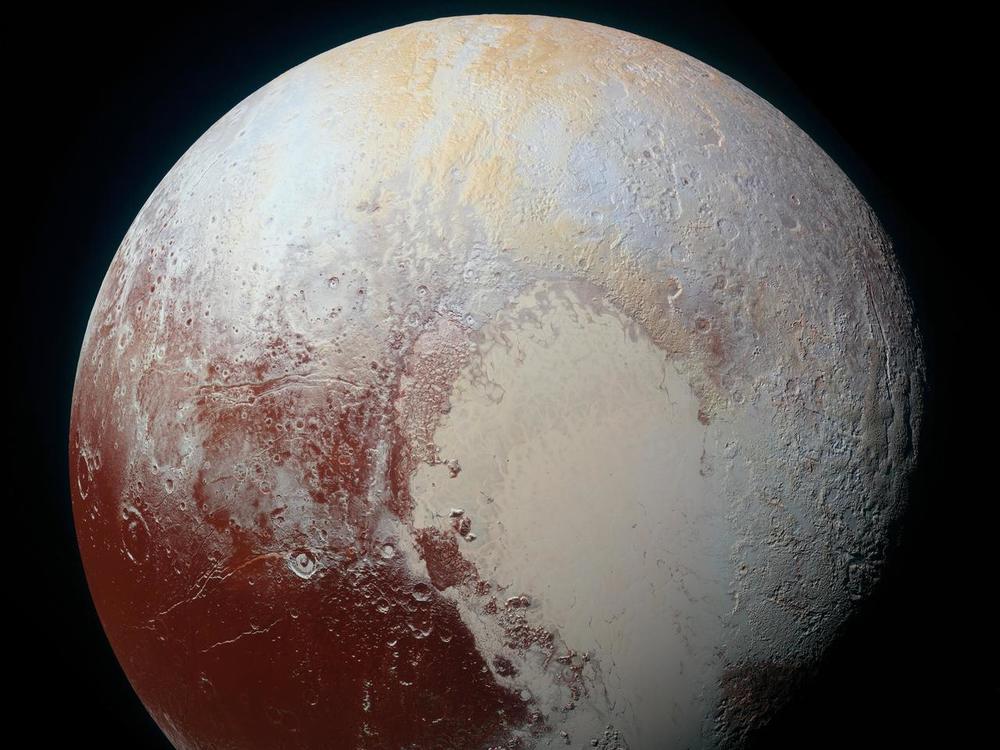Section Branding
Header Content
Pluto Has White-Capped Mountains, But Not Because There's Snow
Primary Content
Pluto is the only place other than Earth in our solar system that's known to have white-peaked mountains, but these white caps aren't made of snow.
Instead, they're made of methane frost. And, according to a new report in the journal Nature Communications, these alien mountains get their peaks whitened in a way that's totally unlike what occurs on Earth's summits.
"Initially, it seemed logical that this high-altitude frost could form like on the Earth," says Tanguy Bertrand, an astronomer at NASA's Ames Research Center in California, who was intrigued by how much Pluto's mountains resembled familiar landscapes here at home.
The mountains that he and his colleagues examined were observed by NASA's New Horizons mission, and they lie west of a big heart-shaped glacier at Pluto's equator. They're about two and a half miles tall.
"They are comparable to the Alps for Earth, but Pluto is a much smaller object," says Bertrand. "So for Pluto, the mountains are really tall."
A visitor to Pluto would see these dark, red and brown mountains looming above. That's because even though Pluto is, on average, about 40 times farther away from the Sun as the Earth, there's still enough daylight to take in the scenery.
The mountains are made of water ice, as temperatures on this dwarf planet can drop as low as minus 387 degrees Fahrenheit. "Water ice on Pluto is so cold that it's hard, just like rock on Earth," says Bertrand. "That's why you can make mountains of water ice on Pluto."
And the mountains get their brownish color from particles that come from Pluto's haze. "You have to imagine like a dark volcano on Earth covered by ashes," says Bertrand, "and on top you still have these bright deposits, that really look like snow on Earth."
But the bright frosts on the peaks of Pluto's Cthulhu region are mostly made of methane-rich ice, according to a new analysis by the research team. What's more, their simulations revealed that this ice didn't fall out of the sky like snow.
On Earth, of course, snow collects at the tops of mountains because atmospheric temperatures decrease with altitude. At higher altitudes, temperatures at the surface also decrease. When moist winds approach a mountain, they rise up the slope and cool down. Water condenses to form clouds and snow at the mountain's peak.
Not so on Pluto. There, the atmosphere is heated by the Sun and actually gets warmer as altitude increases, says Bertrand. The surface temperature, meanwhile, remains uniformly cold. "The wind on Pluto tends to flow downslope," he says, "so it's very different conditions."
And on Pluto, there's no need for wind to bring gaseous methane up the side of a mountain. It's already up there, because more gaseous methane is found at high altitudes. That means the tall, shockingly cold water-ice mountains are poking up into a region that is rich in methane. There, all the action happens at the cold surfaces, where methane forms frost.
"You have gaseous methane in the atmosphere and this gaseous methane directly condenses to the surface, which is cold," says Bertrand. "You have no formation of clouds, and you have no formation of icy particles in the atmosphere. It's not snowing on Pluto."
He says images from the New Horizons probe show that the frost deposits may change with the seasons. That's because some areas of the mountain look reddish rather than brown, suggesting that methane frost was there in another season and offered protection from things like cosmic rays that can darken the surface.
These unusual mountain frosts might form on other bodies in the solar system, such as Triton, a moon of Neptune, says Bertrand, "but it has not been observed yet. And Triton is relatively flat, actually. So you may not even have enough mountains for this process to occur."
Copyright 2020 NPR. To see more, visit https://www.npr.org.


